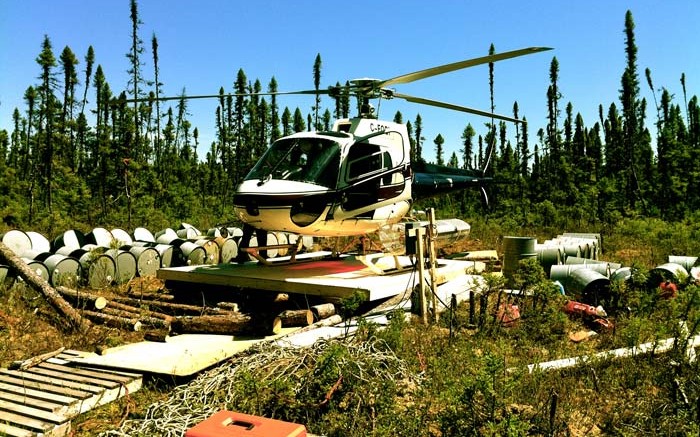Shares of Balmoral Resources (TSX: BAR; US-OTC: BALMF) surged 21% to $1.04, with 4.6 million shares trading hands after the junior reported an intercept of 1,138 grams gold per tonne over 4.9 metres, including 9,710 grams gold over 0.57 metre at its Bug Lake Footwall zone on its flagship Martiniere property in Quebec’s Abitibi region, 45 km east of Detour Gold’s (TSX: DGC; US-OTC: DRGDF) Detour gold deposit.
The intercept in drill hole 14-143 lies within a 71-metre-wide gold mineralized interval cutting the Footwall and Bug Lake gold zones. The hole is one of the deepest tests of the Bug Lake Gold trend so far, and a recent drill program extended the Bug Lake gold zone to a 400-metre vertical depth, including a 8.25-gram-gold intercept over 14.5 metres associated with the lower steep. The zones remain open below this depth.
(The latest drill results improve Balmoral’s understanding of the geometry and potential of the lower, downdip “steep” section of the Bug Lake zone. The Bug Lake gold trend is characterized by steeply dipping segments Balmoral calls “steeps,” which are connected by shallow, east-dipping segments it calls “flats.”)
Drilling has intersected greater thicknesses, and typically higher grades, along the steeps. Drilling along the northern, 375-metre-long segment of the Bug Lake gold trend has intersected a steep in the near-surface and reveals a second, well-mineralized steep at depths ranging between 150 and 400 metres extending beyond the current vertical level of testing.
The Bug Lake fault is a north- to northwest-trending fault zone that separates the Martiniere West and Martiniere East areas. This fault zone has been filled by a silica alteration zone, veining and gold mineralization. Drilling has intersected the discovery for over 400 metres along strike, and it remains open in all directions.
Three holes in Balmoral’s 15-hole winter drill program were also completed along the southern extension of the Bug Lake gold trend to see if the intercepts reflected flats or steeps. Five hundred metres south of drill hole 13-143 on the northern segment, the company identified high-grade gold mineralization associated with a newly identified steep section of the Bug Lake fault zone. Drill hole 14-142 cut 9.35 grams gold over 5.2 metres and 4.78 grams gold over 2.7 metres from the upper and lower contacts of the Bug Lake porphyry, in the deepest hole along the southern extension.
“A deeper “steeps” zone in the north and the discovery of a similar deep “steeps” segment along the southern extension demonstrate the potential for additional gold-mineralized extensions along the Bug Lake trend,” write Haywood Securities analysts Mike Carew and Kerry Smith. “In addition, the bonanza-grade intervals drilled along the northern extension are a testament to the high-grade potential of the gold-mineralized system.”
The Bug Lake and associated gold zones are parallel to the 20- to 50-metre wide north- to northwest-trending, steeply east-dipping Bug Lake fault zone, which separates mafic intrusive and mafic volcanic lithologies on the Martiniere property. A 5- to 30-metre wide north- to northwest-trending felsic porphyry dyke is located within the fault corridor.
Gold mineralization occurs in distinct shear-vein zones in the footwall and hangingwall to the porphyry, as well as within silica-flooded fault breccias in the Bug Lake zone.
In the Bug Lake area, gold mineralization is associated with disseminated pyrite mineralization, with the high- to bonanza-grade intervals containing abundant fine free gold.
Drilling at Martiniere is expected to resume in late June or early July and will concentrate on expansion and infill drilling along the northern segment of the Bug Lake gold trend, testing of the newly identified steep along the southern extension, and the testing of other high-priority targets.
The Martiniere gold system has been traced for over 1,500 metres and remains open in all directions. The system is 2 km north of the Sunday Lake deformation zone, which hosts the Detour Gold deposit. The Sunday Lake deformation zone traverses the southern part of the Martiniere property and is largely untested across the 9.5 by 7 km property.
Balmoral was founded in 2010. The company’s CEO Darin Wagner spent the first decade of his career at Noranda and Cominco. He then went on to New Millennium Metals, which merged with Platinum Group Metals in 2002.
In 2005 Wagner became president of Sydney Resource, and in 2006 engineered its merger with Band-Ore Resources to form West Timmins Mining. The Thunder Creek discovery on the West Timmins project in Timmins led to the sale of the company in late 2009 to Lake Shore Gold (TSX: LSG; NYSE-MKT: LSG) in an all-share deal worth $424 million.


Be the first to comment on "Balmoral shares surge on Bug Lake results"